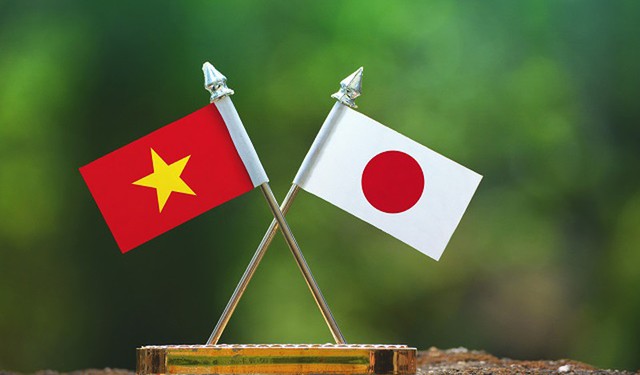Rock-solid relationship between Viet Nam and Japan
VGP - The bilateral trade between Viet Nam and Japan has grown over 90-fold in the past three decades, thanks to proactive efforts in trade liberalization, making Japan Viet Nam’s fourth-largest trading partner, according to HSBC.

In its report Viet Nam at a glance, HSBC noted that Viet Nam's significance in Japan's trade has also risen compared to ASEAN peers.
But it is more than just trade. Japan is also Viet Nam's third-largest FDI provider, as well as the top official development assistance (ODA) donor and the main destination for Vietnamese overseas workers.
Over the past three decades, these developments have helped lay solid foundations for Viet Nam's impressive development story, the bank highlighted.
As 2023 marks 50 years of the diplomatic relationship between Japan and Viet Nam, HSBC takes this opportunity to assess the significant linkages in their economic ties.
Just as recently as last week, both countries have agreed to elevate their ties to a "comprehensive strategic partnership", a top-tier relationship that Viet Nam has only granted to China, Russia, South Korea, India, and most recently to the U.S., during President Biden's visit in September.
A first look at their trade relationship merits attention. While the share of Viet Nam's exports to Japan has been gradually declining, total trade between Japan and Viet Nam has grown by a 15.2 percent Compound Annual Growth Rate (CARG) since 1990.
Undoubtedly, the impressive performance was aided by Viet Nam's accession to the WTO in 2007, followed by the economic partnership agreements between Japan and ASEAN (AJCEP) effective 2008, and between Japan and Viet Nam (VJEPA) effective 2009.
Total trade exceeded US$47 billion in 2022, making Japan the fourth-largest trading partner of Viet Nam, reflecting robust economic ties.
Even within the ASEAN bloc, Viet Nam has become more involved in Japan's trade activity. While ASEAN's share in Japan's trade has remained steady at just under 15 percent, Viet Nam has nonetheless raised its significance within the bloc.
Looking more closely at the breakdown of Viet Nam's exports to Japan, certain categories stand out: consumer electronics/machinery/transport (35 percent), textiles/footwear (26 percent), and raw materials (18 percent) such as wood and plastics.
In fact, Viet Nam's emergence as a smartphone export powerhouse to Japan has materialized in 2016 and 2017, reflecting the shift in smartphone production by Korean tech giants offshore.
Opportunities also lie beyond increasing exports of major products currently being traded. For example, selected fruits, such as nuts, have been growing in demand.
Entrance of retail and finance
According to HSBC, beyond trade, it is no secret that Japan has been a key direct investor in ASEAN. For Viet Nam, in particular, Japan has been its third-largest source of FDI, reaching close to US$70 billion by 2022, trailing after Korea and Singapore.
Recently, it is not just greenfield investments in manufacturing. Rising income and the proliferation of discretionary spending have created opportunities in retail as well as financial services, subsequently attracting investment from Japanese firms.
Japanese retail group Aeon, which stands out as a notable example, announced its intention to expand its number of department stores in Viet Nam from six currently to 30 by 2030.
Mizuho, one of Japan's megabanks, has steadily made share purchases in Vietnamese companies such as leading digital payment provider M-Service, as well as state-owned commercial bank Vietcombank.
While competition in these spaces is intensifying, as evident from global peers such as Thailand's Central Group becoming similarly more involved, it is clear that the growing consumer potential in Viet Nam is an opportunity for a new group of Japanese firms looking to invest.
Enabling development
In addition, it is also important to remember that infrastructure and development have provided a platform for these opportunities to flourish, HSBC underlined.
In this case, Japan has been the largest ODA provider to Viet Nam. Cumulatively, Japan has provided over JPY3 trillion in ODA to Viet Nam, making the latter one of the top five recipients of Japanese ODA.
In fact, most of these loans have been used to develop critical infrastructure, such as Noi Bai International Airport and Nhat Tan bridge.
The other key area worth highlighting is the remittance flows from Japan to Viet Nam, as an important source of steady foreign income. Japan, Taiwan (China), and South Korea are the top three destinations for Vietnamese overseas workers.
All in all, Japan and Viet Nam's economic relationship carries significant weights on many metrics. While Japanese firms originally approached Viet Nam as a cost-competitive offshore manufacturing base, the latter's robust economic growth story has created new avenues for the relationship to develop, especially for higher value-added activities, stated HSBC./.

